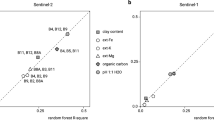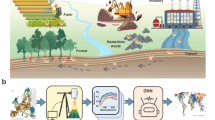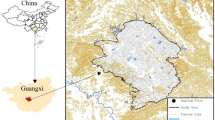Abstract
China faces widespread soil arsenic pollution caused by intensified industrial and agricultural activities, the impacts of which, however, have never been evaluated at the national scale. In this study, we developed a machine-learning model built on 3,524 surveys, representing over one million soil samples, to generate annual maps of arsenic concentration in China’s surface soils for the period 2000–2040. The model has uncovered a worrying trend of increasing arsenic concentrations, rising from a mean of 11.9 mg kg−1 in 2000 to 12.6 mg kg−1 in 2020, with an anticipated further increase to 13.6 mg kg−1 by 2040. The primary anthropogenic causes have been identified as non-ferrous mining activities (68.0%), followed by energy consumption (15.8%), smelting (13.2%) and farming practices (3.0%). Furthermore, in 2000, 2020 and 2040, the model predicts that 13.0%, 17.1% and 18.3% of rice production and 10.0%, 13.9% and 15.9% of the population, respectively, would be located on soils with arsenic concentrations over 20 mg kg−1. Despite the establishment of initiatives such as the Soil Pollution Prevention and Control Action Plan by the Chinese government to restrain this burgeoning arsenic pollution, our findings underscore the urgent need for more vigorous measures to stall or reverse this disturbing trend.
This is a preview of subscription content, access via your institution
Access options
Access Nature and 54 other Nature Portfolio journals
Get Nature+, our best-value online-access subscription
$29.99 / 30 days
cancel any time
Subscribe to this journal
Receive 12 digital issues and online access to articles
$119.00 per year
only $9.92 per issue
Buy this article
- Purchase on Springer Link
- Instant access to full article PDF
Prices may be subject to local taxes which are calculated during checkout





Similar content being viewed by others
Data availability
Arsenic concentration data for soil and rice samples are available via Figshare at https://doi.org/10.6084/m9.figshare.25477366 (ref. 54). Data for the predictive variables are provided in the Supporting Information.
Code availability
The codes for this study are available via Figshare at https://doi.org/10.6084/m9.figshare.25477366 (ref. 54).
References
Mandal, B. K. & Suzuki, K. T. Arsenic round the world: a review. Talanta 58, 201–235 (2002).
Wilson, S. C., Lockwood, P. V., Ashley, P. M. & Tighe, M. The chemistry and behaviour of antimony in the soil environment with comparisons to arsenic: a critical review. Environ. Pollut. 158, 1169–1181 (2010).
Renu, K. et al. Role of arsenic exposure in adipose tissue dysfunction and its possible implication in diabetes pathophysiology. Toxicol. Lett. 284, 86–95 (2018).
Zhao, F. J., Ma, J. F., Meharg, A. & McGrath, S. Arsenic uptake and metabolism in plants. New Phytol. 181, 777–794 (2009).
Li, Z., Ma, Z., van der Kuijp, T. J., Yuan, Z. & Huang, L. A review of soil heavy metal pollution from mines in China: pollution and health risk assessment. Sci. Total Environ. 468, 843–853 (2014).
Liu, J. et al. Chronic arsenic poisoning from burning high-arsenic-containing coal in Guizhou, China. Environ. Health Perspect. 110, 119–122 (2002).
Muehe, E. M. & Kappler, A. Arsenic mobility and toxicity in South and South-east Asia—a review on biogeochemistry, health and socio-economic effects, remediation and risk predictions. Environ. Chem. 11, 483–495 (2014).
Das, D. et al. Arsenic in groundwater in six districts of West Bengal, India. Environ. Geochem. Health 18, 5–15 (1996).
Pandey, V. C., Singh, J. S., Singh, R. P., Singh, N. & Yunus, M. Arsenic hazards in coal fly ash and its fate in Indian scenario. Resour. Conserv. Recycl. 55, 819–835 (2011).
Mestrot, A., Merle, J. K., Broglia, A., Feldmann, J. & Krupp, E. M. Atmospheric stability of arsine and methylarsines. Environ. Sci. Technol. 45, 4010–4015 (2011).
Zheng, M.-Z., Li, G., Sun, G.-X., Shim, H. & Cai, C. Differential toxicity and accumulation of inorganic and methylated arsenic in rice. Plant Soil 365, 227–238 (2013).
Juhasz, A. L. et al. Assessment of four commonly employed in vitro arsenic bioaccessibility assays for predicting in vivo relative arsenic bioavailability in contaminated soils. Environ. Sci. Technol. 43, 9487–9494 (2009).
National Soil Pollution Survey Report (Ministry of Environmental Protection and Ministry of Land Resources, 2014).
Jin, L. The main work of the detailed survey of agricultural land is completed. The soil environmental condition of agricultural land is generally stable. Economic Daily (30 November 2019).
Panagos, P., Jiskra, M., Borrelli, P., Liakos, L. & Ballabio, C. Mercury in European topsoils: anthropogenic sources, stocks and fluxes. Environ. Res. 201, 111556 (2021).
Ballabio, C. et al. A spatial assessment of mercury content in the European Union topsoil. Sci. Total Environ. 769, 144755 (2021).
Rodríguez-Lado, L. et al. Groundwater arsenic contamination throughout China. Science 341, 866–868 (2013).
Podgorski, J. & Berg, M. Global threat of arsenic in groundwater. Science 368, 845–850 (2020).
Podgorski, J. E. et al. Extensive arsenic contamination in high-pH unconfined aquifers in the Indus Valley. Sci. Adv. 3, e1700935 (2017).
Podgorski, J. & Berg, M. Global analysis and prediction of fluoride in groundwater. Nat. Commun. 13, 4232 (2022).
Podgorski, J. E., Labhasetwar, P., Saha, D. & Berg, M. Prediction modeling and mapping of groundwater fluoride contamination throughout India. Environ. Sci. Technol. 52, 9889–9898 (2018).
Amini, M. et al. Statistical modeling of global geogenic fluoride contamination in groundwaters. Environ. Sci. Technol. 42, 3662–3668 (2008).
Roudier, P. et al. National scale 3D mapping of soil pH using a data augmentation approach. Remote Sens. 12, 2872 (2020).
Agrawal, A. & Petersen, M. R. Detecting arsenic contamination using satellite imagery and machine learning. Toxics 9, 333 (2021).
Breiman, L. Random forests. Mach. Learn. 45, 5–32 (2001).
Soil Environmental Quality Risk Control Standard for Soil Contamination of Agricultural Land: GB 15618-2018 (Ministry of Ecology and Environment of the People’s Republic of China, 2018).
Zhou, Q., Teng, Y. & Liu, Y. A study on soil-environmental quality criteria and standards of arsenic. Appl. Geochem. 77, 158–166 (2017).
Soil Environmental Quality Risk Control Standard for Soil Contamination of Development Land: GB 36600-2018 (Ministry of Ecology and Environment of the People’s Republic of China, 2018).
National Food Safety Standard—Maximum Levels of Contaminants in Foods (National Health Commission of the People’s Republic of China, 2022).
Shi, J., Zhao, D., Ren, F. & Huang, L. Spatiotemporal variation of soil heavy metals in China: the pollution status and risk assessment. Sci. Total Environ. 871, 161768 (2023).
Han, F. X. Biogeochemistry of Tace Elements in Arid Environments (Springer, 2007).
Chapagain, S., Shrestha, S., Du Laing, G., Verloo, M. & Kazama, F. Spatial distribution of arsenic in the intertidal sediments of River Scheldt, Belgium. Environ. Int. 35, 461–465 (2009).
Kumarathilaka, P., Seneweera, S., Meharg, A. & Bundschuh, J. Arsenic speciation dynamics in paddy rice soil-water environment: sources, physico-chemical, and biological factors—a review. Water Res. 140, 403–414 (2018).
Gong, Y. et al. Status of arsenic accumulation in agricultural soils across China (1985–2016). Environ. Res. 186, 109525 (2020).
Xu, Y., Bi, R. & Li, Y. Effects of anthropogenic and natural environmental factors on the spatial distribution of trace elements in agricultural soils. Ecotoxicol. Environ. Saf. 249, 114436 (2023).
Zhu, Y.-G. et al. High percentage inorganic arsenic content of mining impacted and nonimpacted Chinese rice. Environ. Sci. Technol. 42, 5008–5013 (2008).
García-Salgado, S., García-Casillas, D., Quijano-Nieto, M. A. & Bonilla-Simón, M. M. Arsenic and heavy metal uptake and accumulation in native plant species from soils polluted by mining activities. Water Air Soil Pollut. 223, 559–572 (2012).
Walsh, L. M., Sumner, M. E. & Keeney, D. R. Occurrence and distribution of arsenic in soils and plants. Environ. Health Perspect. 19, 67–71 (1977).
Jayasumana, C. et al. Phosphate fertilizer is a main source of arsenic in areas affected with chronic kidney disease of unknown etiology in Sri Lanka. SpringerPlus 4, 90–97 (2015).
Dittmar, J. et al. Arsenic accumulation in a paddy field in Bangladesh: seasonal dynamics and trends over a three-year monitoring period. Environ. Sci. Technol. 44, 2925–2931 (2010).
Duan, G., Liu, W., Chen, X., Hu, Y. & Zhu, Y. Association of arsenic with nutrient elements in rice plants. Metallomics 5, 784–792 (2013).
Smedley, P. L. & Kinniburgh, D. G. A review of the source, behaviour and distribution of arsenic in natural waters. Appl. Geochem. 17, 517–568 (2002).
Ma, L. Q. et al. A fern that hyperaccumulates arsenic. Nature 409, 579 (2001).
Zhu, Y.-G., Williams, P. N. & Meharg, A. A. Exposure to inorganic arsenic from rice: a global health issue? Environ. Pollut. 154, 169–171 (2008).
Li, G., Sun, G.-X., Williams, P. N., Nunes, L. & Zhu, Y.-G. Inorganic arsenic in Chinese food and its cancer risk. Environ. Int. 37, 1219–1225 (2011).
Chen, S. et al. A high-resolution map of soil pH in China made by hybrid modelling of sparse soil data and environmental covariates and its implications for pollution. Sci. Total Environ. 655, 273–283 (2019).
Neumann, R. B. et al. Anthropogenic influences on groundwater arsenic concentrations in Bangladesh. Nat. Geosci. 3, 46–52 (2010).
Qu, C. et al. China’s soil pollution control: choices and challenges. Environ. Sci. Technol. 50, 13181–13183 (2016).
Lee, P.-K. et al. Source identification of arsenic contamination in agricultural soils surrounding a closed Cu smelter, South Korea. Chemosphere 217, 183–194 (2019).
Muehe, E. M., Wang, T., Kerl, C. F., Planer-Friedrich, B. & Fendorf, S. Rice production threatened by coupled stresses of climate and soil arsenic. Nat. Commun. 10, 4985 (2019).
de Menezes, M. D. et al. Modeling arsenic content in Brazilian soils: what is relevant? Sci. Total Environ. 712, 136511 (2020).
Olle, S. Essentials of Medical Geology: Revised Edition (Springer, 2013).
National Bureau of Statistics. China Statistical Yearbook (China Statistics, 2001–2021).
Zhang, S. et al. Escalating arsenic contamination throughout Chinese soils. Figshare https://doi.org/10.6084/m9.figshare.25477366 (2024).
Acknowledgements
We express our deepest appreciation to D. Zhou of Nanjing University, whose insightful comments and invaluable guidance played a pivotal role in the preparation of this paper. We also thank the many providers of data, which were an essential component of this work. We acknowledge the National Earth System Science Data Center, the National Tibetan Plateau Data Center and Geospatial Data Cloud for data support. This work was supported by the National Natural Science Foundation of China (grant nos. 42077140 (Y.Y.) and 41991330 (Y.L.)), the National Key Research and Development Program of China (grant nos. 2020YFC1807002 (Y.Y.), 2021YFC1809103 (Y.Y.) and 2022YFD1700104 (Y.L.)), Chinese Academy of Sciences (grant no. Y912010 (Y.Y.)), the Natural Science Foundation of Jiangsu Province (grant no. BK20231461 (J.Z.)) and the Conservation of Biodiversity in China in the light of Climate Change (CHN-2152, 18/0015, (Q.C.)).
Author information
Authors and Affiliations
Contributions
Y.Y. designed the study. Shuyou Zhang, L.N., Q.Z. and N.X. collected the data. Y.Y., Shuyou Zhang and J.Z. performed the modelling. Y.Y., Shuyou Zhang and J.Z. wrote the first complete draft of the paper. Y.Y., Shuyou Zhang and J.Z. revised the paper with inputs from all co-authors. Y.Y., Shuyou Zhang, J.Z., L.N., Q.C., Q.Z., N.X., J.M., J.M., C.W., Songhe Zhang and Y.L. contributed to the interpretation of results, writing and revision of the paper.
Corresponding author
Ethics declarations
Competing interests
The authors declare no competing interests.
Peer review
Peer review information
Nature Sustainability thanks the anonymous reviewers for their contribution to the peer review of this work.
Additional information
Publisher’s note Springer Nature remains neutral with regard to jurisdictional claims in published maps and institutional affiliations.
Supplementary information
Supplementary Information
Supplementary Tables 1–6, Figs. 1–6 and references.
Rights and permissions
Springer Nature or its licensor (e.g. a society or other partner) holds exclusive rights to this article under a publishing agreement with the author(s) or other rightsholder(s); author self-archiving of the accepted manuscript version of this article is solely governed by the terms of such publishing agreement and applicable law.
About this article
Cite this article
Zhang, S., Zhang, J., Niu, L. et al. Escalating arsenic contamination throughout Chinese soils. Nat Sustain (2024). https://doi.org/10.1038/s41893-024-01341-7
Received:
Accepted:
Published:
DOI: https://doi.org/10.1038/s41893-024-01341-7



